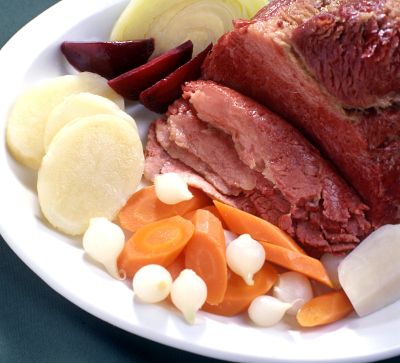Corned O’plenty
Historic debate aside, St. Patrick’s Day the perfect time to make your own corned beef

With the imminent arrival of St. Patrick’s Day, our attention turns to all thing Irish. Soda bread. Potatoes. Corned beef.
The role of corned beef in Irish cuisine is up for debate. According to the Web sites europeancuisines.com and irishcultureandcustoms.com, corned beef was the food of kings, as beef was too expensive for average folks, and thus never really part of the cultural fabric.
Still, there’s no doubt that corned beef – often accompanied by boiled cabbage, potatoes and carrots – has been embraced by Irish-Americans, who serve it to celebrate their heritage at St. Patrick’s Day.
With that in mind, we turn our attention to making corned beef. First off, there is no corn involved in corned beef. The word “corned” here is a form of “cured.”
Beef, typically a brisket, is soaked in a spiced brine solution for at least five days before the meat is slowly cooked in water. Saltpeter – potassium nitrate – often is added to cure the meat. It also gives the meat its distinctive red color, and keeps the boiled meat from turning an unappealing gray.
This time of year, corned beef is readily available at grocery store meat counters, mass produced and shipped in from large processing centers.
A handful of local meat shops, however, will corn their own beef, including Tim’s Special Cuts Meats in Coeur d’Alene and Sonnenberg’s in Spokane.
Clyde Sonnenberg said they do a big corned beef business this time of year. “I think we put down 14,000 pounds of brisket this year,” he said.
Their recipe, he added, hasn’t changed in the 25 years he and wife, Lucy, have owned the business. In fact, they got the recipe from the shop’s previous owners.
Tim Branen of Tim’s said brisket isn’t the only option for corning, although typically it is the most economical. They also corn bottom round or eye of round.
“If you really want to go overboard, tri-tip is really good corned,” he said, adding that you could even corn a 2-inch chuck roast.
At Tim’s, they’ll use a traditional pickling spice blend – which can include allspice, bay leaves, cardamom, cinnamon, cloves, coriander, ginger, mustard seeds and peppercorns, among other spices – and will soak the meat for a week at a minimum.
Making corned beef takes a lot of time, but much of it is hands off. And if you get started today or Thursday, you could have yourself a homemade corned beef dinner by Tuesday.
This recipe, from Hugh Fearnley-Whittingstall’s “The River Cottage Meat Book,” lists the saltpeter as optional. If you want to use it, ask your favorite butcher shop if they have some to share, or order it online for use next year.
One final tip: Cut the beef against the grain to ensure a tender texture.
Corned Beef
Adapted from “The River Cottage Meat Book,” by Hugh Fearnley-Whittingstall
5 quarts water
1 pound Demerara sugar or light brown sugar
2 pounds coarse sea salt
1 teaspoon black peppercorns
1 teaspoon juniper berries
5 cloves
4 bay leaves
A sprig of thyme
3 tablespoons saltpeter (optional)
1 (4- to 6-pound) piece of beef (brisket or flank)
1 bouquet garni (typically thyme, parsely and bay leaf)
1 carrot, chopped
1 onion, chopped
1 celery stalk, chopped
1 leek, chopped
1/2 garlic bulb
Put the brine ingredients (water through saltpeter) into a large saucepan and stir well over low heat until the sugar and the salt have dissolved. Bring to a boil, allow to bubble for 1 to 2 minutes, then remove from the heat and allow to cool completely.
Place your beef in a nonmetallic container, such as a large Tupperware container or a clay crock. Cover the meat completely with the cold brine, weighing it down if necessary. Refrigerate for 5 to 10 days. (Cuts less than 6 pounds should not be left for more than a week, or they will become too pickled.)
Before cooking, remove the beef from the brine and soak it in fresh cold water, changing with fresh water at least once, overnight or up to 48 hours if you did the full 10-day soak in the brine.
Place the meat in a pan with the bouquet garni, vegetables and garlic, cover with fresh water, and bring to a gentle simmer. Poach very gently on the stove, or in a very low oven (275 degrees), if you prefer.
Cook the meat until completely tender and yielding when pierced with a skewer. A 6-pound piece of beef will take 2 1/2 to 3 hours.
Yield: 8 servings.